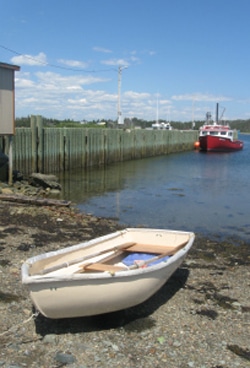
Zartman- dinghy in Nova Scotia
These are now the longest days of the year, and up here at 45 degrees north latitude, halfway from equator to pole, there’s daylight in plenty. A good thing, too, since we were trying to make good time east along the coast. We could get up with the sun, get underway after breakfast, and after making thirty or forty miles along the coast, still be anchored in time to give the children a good run on shore, have a leisurely supper, and go to bed with the sun still glinting through the portholes. I had thought it would be difficult to get to sleep while sunbeams danced on the deckhead, but it’s actually no trouble whatsoever—just like lying down for an afternoon siesta, which is one of my greatest and rarest delights.
Another delight was the clearness of the sky—the fog took a long break, and hasn’t come back as I write this a week after our exciting entrance into Passage Island. The clearness was crucial to our plans, since we wanted to wind through the more sheltered waters inshore of all the off lying islands, and good visibility is essential. Lots of the shoals are marked only by the seas that break on them, and the antiquity of our charts means that not all charted buoys exist any more, some existing ones have been moved, and there’s a new buoy here and there also.

Pumpkin Island did not resemble a pumpkin, though it looked strangely similar to Pumpkin Hill on Utila Island in Honduras, several thousand miles away. Maybe the early explorers had only seen pumpkins that had been allowed to rot on the vine and get stove in a little aloft. Or maybe, being sailors, they knew as little about gardening as I do, and couldn’t tell a pumpkin from a rutabaga. Either way, it gave us food for thought as Ganymede wound her way between groups of foaming breakers and low-lying islands, past Necum Teuch and Ecum Secum harbors (the girls were horribly disappointed that we didn’t go in there), and six gybes later into Hawbolt Cove in Marie Joseph Harbor.
Here we encountered again one of the disadvantages of cruising in first-world countries. Even though there’s a town, since every soul owns a car there’s no need for supermarket, convenience store or roadside food stand nearby. That same town in Mexico or Central America would have had some sort of general store, a restaurant or two, and maybe (oh, fond memories!) a taco or pupusa or arepa stand next to a bus stop. Our next port of call, Isaac’s Harbor, was as bereft of services—just rows of houses among hopelessly overgrown lawns, and hardly a soul to be seen.
It was not until we arrived at the eastern end of Nova Scotia—Canso Harbor—on Saturday, that we found our first grocery store since leaving Halifax. Coming through the narrow, winding Andrews Passage under sail alone had been pretty exciting, as had been tacking into the broad, deep harbor to an anchor spot, but most exciting was finding the Co-op supermarket stocked with all sorts of fresh meat and veggies on sale. Almost as good was the “Marina”, which while it had neither depth or turning room for sailboats, had showers and laundry. A third joy was the brand-new library, with very good wifi, children’s play area, and couches ranged around a cozy ceramic-log fireplace. So what if it had hardly any books? It had Legos, which were far better—and noisier—than the reading material they did have.
Though it’s very deep and feels open, with the wind accelerating as it shoots over the low surrounding hills, Canso is still a pretty good harbor. Our initial thought had been to try and move to the Tickle—a narrow inlet at the far end of the bay—but an inspection from land banished that thought. It would be, as Danielle pointed out, “Ticklish” getting in there. As long as the wind stayed in the Southern quadrant there was nothing more that could be desired for our anchoring spot, and after a very windy first night set the anchor good and hard, we had no fears for it coming loose.
We are the Zartman family: Ben & Danielle, and our three girls, Antigone, Emily and Damaris. We created this blog to chronicle our sailing adventures on Ganymede, a home-finished 31-foot gaff-rigged cutter, which has been our home since 2009, when we sailed from San Francisco, California, to the Sea of Cortez, then down along the Central American coast. Currently in Newport, Rhode Island, we plan to sail to Canada, the U.K., and beyond this summer.








